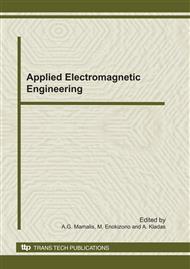p.110
p.118
p.122
p.131
p.137
p.142
p.151
p.158
p.164
New Signal Processing Method for Electromagnetic Inspection Using Multidirectional Magnetizing Type Sensor
Abstract:
New signal processing method for Electromagnetic Inspection using multidirectional magnetizing type sensor has been developed to detect linear-shaped defects such as cracks in every direction in test objects. In this method, the Amplitude-Modulated alternating currents, whose waveforms are the product of two sinusoidal waves of different frequencies, are used to produce a rotating magnetic field in test objects. The signal caused by a lift off variation of the sensor, which is not avoidable by conventional multidirectional magnetizing method, is reduced by this method. The effect is investigated by a test using 0.25% carbon steel sheet. It is also investigated that the inclined angles of defects are obtained by the phase information of the signal in a phasor diagram.
Info:
Periodical:
Pages:
137-141
Citation:
Online since:
December 2010
Authors:
Keywords:
Price:
Сopyright:
© 2011 Trans Tech Publications Ltd. All Rights Reserved
Share:
Citation:


